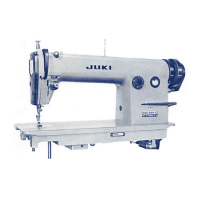Malfunctions
I. Machine does
not
stop
at the
uppei
or lower fixed
position
(The
stopping position
of
the
needle
is
not
definite)
- 31
1. Auxiliary driving device
of the motor or the special
function
of
the
brake
is
not
working right
Causes
Insufficient voltage
of
electrical source for the
brake
and
auxiliary motor device or wrong connection
of
the dis
connecting
cord
a) When connecting the electrical cord
of
HITACHI motor
to the transformer of the control box, the method
of
connection
is
wrong
b)
The
fuse
of
the
control
box
Is
blown
out
The
magnet
brake
of
the
motor
is defective
Auxiliary
motor
is
defective
Defective bi-directional-triode thyristor
Order
of
Inspection
and
Corrective
Measures
(D
Inspect
the
6A
and1A
fuses
andif
blown
out,
replace
them
with
new
ones.
(D
Check
the
voltage
of
the
switch
part
and
if it is
normal,
measure
the
voltage
of
alternate
current
of the
transformer
inside
the
control
box.
If the
voltage
between
0 and 3IV is 25~37V, it is
normal.
If not, the
connecting
method
of the input cord to the transformer is wrong, so correct it.
(D Put out all the input cords, once, and correct the insertions.
(D Inspect the
clearance
of the magnetbrake.
Remove the cover of the magnet brake and adjust so
that
the clearance between
the brake plate and the brake friction plate becomes
O.Smm.
(For full
dctail.<i.
refer to Instruction Book of Hitachi and National motors).
®
Inspect
the
disconnection
or
shorting
of the
magnet
brake.
Pull
out tlie
black
plugging cord inside the control box, measure the resistance between the No.3
(red lead wire) and No.4(yellow lead wire) and if it's
"0"
or they are dis
connected
or shorted and if the connection of the cords is nonnal,
exchange
the
magnet
brake.
(D
Remove
the
black
cap
of
the
tip
of
the
cord
coming
out
from
the
motor,
remove
the end
cover
of the
motor,
also,
and by
removing
the
vinyl
cover
of the pin
terminal (3 ea. of 3 phase, 2 ea. of single phase) of the cord which is connected
to the
auxiliary
motor and
measure
the
conductivity
of
respective
pin
terminals
by a tester. If the resistance is
"0"
or
<»,
it means disconnection of the motor
coil or
shorting.
(Be sure to
measure
the
resistance
within
the rangeof R x 1.
Also,
the
tester
should
measure
so that
when
2 test
pins
are
contacted
that
tl>cy
are matched to show the resistance indicator points to "0".)
®
Verify
that
the
low
speed
function
changing
pin
on
top
of
mother
printed
board
is
connected
to the
ON
'
side.
Flip
upthe
black
cap
atthetipofthe
cord
coming
out
from
the
motor,
input
the
current
(pedal
Is
neutral
and
machine
is
stopping)
and
measure
the
voltage
between
the pin
terminals
No.l(whitc)
and
No.2(black)
by
means
of
tester
AC250V
range.
If the
voltage
is
over
40V,
it isokbutifit's
OV,
the
bi-directional-triode
thyristoris
defective.
With
the 3
phase
motor,
measure
between
No.8(grey)
and
No.9(orange)
terminals
in the
same
manner
andif not
over
40V,
the
bi-directional-triode
thyristor
is
defective,
so in
cither
case
exchange
the
defective
thyristor.
(D
When
the
auxiliary
motor is
abnormally
heated,
it
means
defective
bi-directional-
triode thyristor or running with defective phases (of 3 wires, 1 wire is disconnected
or
defective
connection)
®
Step
on the
pedal
to
low
speed
sewing
and
measure
the
voltage
between
No.2(b!ack)
and No.l(white) and if it's "0", it's ok and
similarily
if the
voltage
between
No.8
(grey)and No.9(orange) is "0", it's ok and if any terminals show
voltage
of over40V,
it
means
defective
bi-directional-triode
thyristor.
In
such
a
case,
exchange
the
thyristor.
(Note) The
inspection
of ® will be conductedwith the powersourcein
turned-on
condition, so be extremely careful not to receiveelectric shock. Also,do not
forget to set the range
of
the tester to AC250V.

